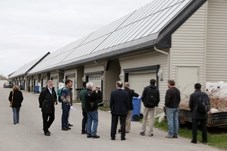Okotoks received worldwide attention last week when members of the International Energy Agency came to visit the renowned Drake Landing Solar Community.
Representatives of the IEA Solar Heating and Cooling committee from 14 different countries as far away as South Africa, China and Denmark came to tour the solar community. The members meet twice a year, and it was Canada’s turn to host the committee, something that happens once every 10 years.
Doug McClenahan, Natural Resources Canada research and development manager, said he was happy to have such an achievement in Canada to show to the group.
“We thought we would bring them to Alberta to show them Drake Landing, because in our opinion, it’s Canada’s most impressive solar thermal project.” he said.
Drake Landing was awarded the 2013 IEA Solar Heating and Cooling award in Germany in recognition of its world record performance levels, heating the 52 homes with over 90 per cent solar energy. Committee chair Werner Weiss from Austria said the numbers were unmatched in similar projects across Europe.
“It’s quite cold here, and to have a high solar fraction where more than 90 per cent space heating comes from solar? There’s a lot of district heating in Denmark, but usually the solar fraction is lower. It’s really quite impressive,” he said.
Dawn Smith, Okotoks sustainability co-ordinator, said she was glad to see the town receiving international attention.
“It’s very exciting to see our community showcased at such an international level. We are very proud to be home to such an innovative and ground breaking project,” she said. “I was very impressed with the diversity of the countries attending and the knowledge base.”
Smith is also hoping recognition of the achievement will help lead to similar projects in the future.
“With Okotoks growing and the technology already being tested here and Okotoks having some of the best solar availability in the world we hope to do something on a larger scale,” she said.
Weiss said that since the project is in its seventh successful year, it’s a good indicator that other similar projects would work here as well.
“You need to show it’s working, and then when you have more projects it brings down the price,” he said.
The bill for Drake Landing came in at $7 million, with one third of the costs being research related, meaning that a similar project with the same technology would come in at a lower cost. In addition, McClenahan said Alberta is a good candidate for future projects because of funds available here for clean energy technology.
“We hope it’s not just going to be a one off project. This was built to demonstrate the concept, wasn’t intended that we would duplicate it on this small scale, we would go up to a much higher scale whether it’s 200 or 500 or 1,000 homes,” he said. “I see an opportunity here still in Alberta to build the next large scale one for sure.”




